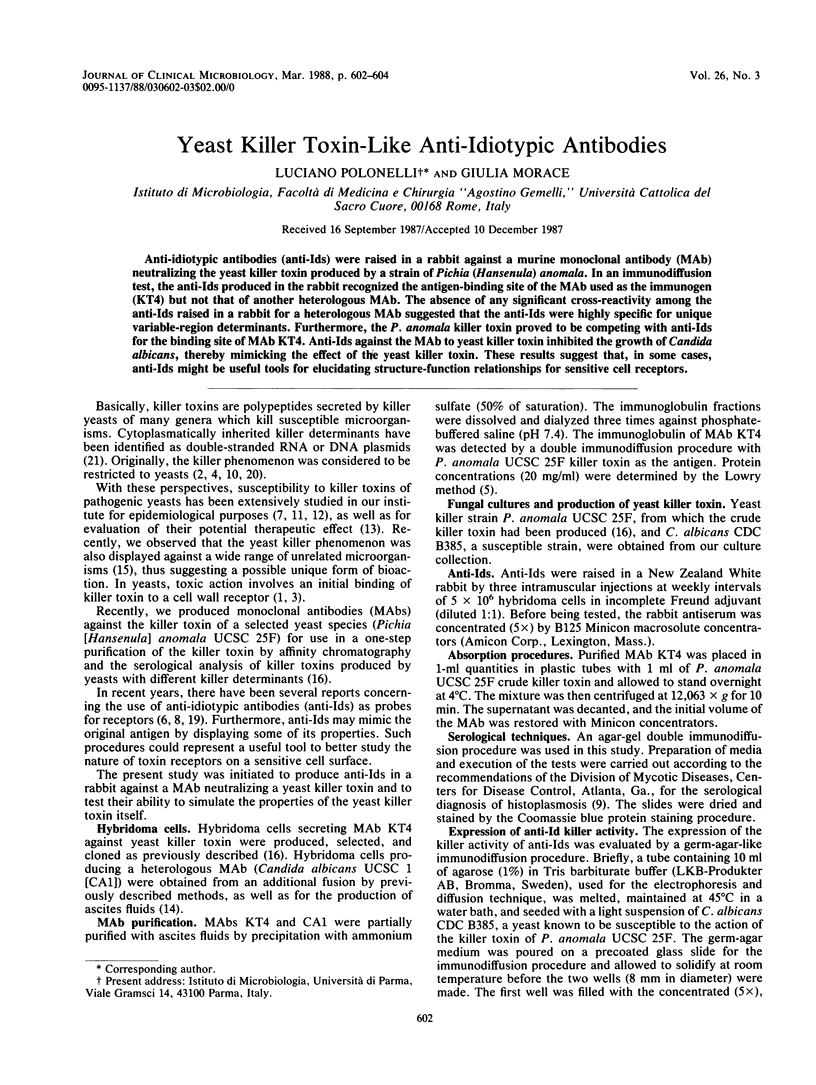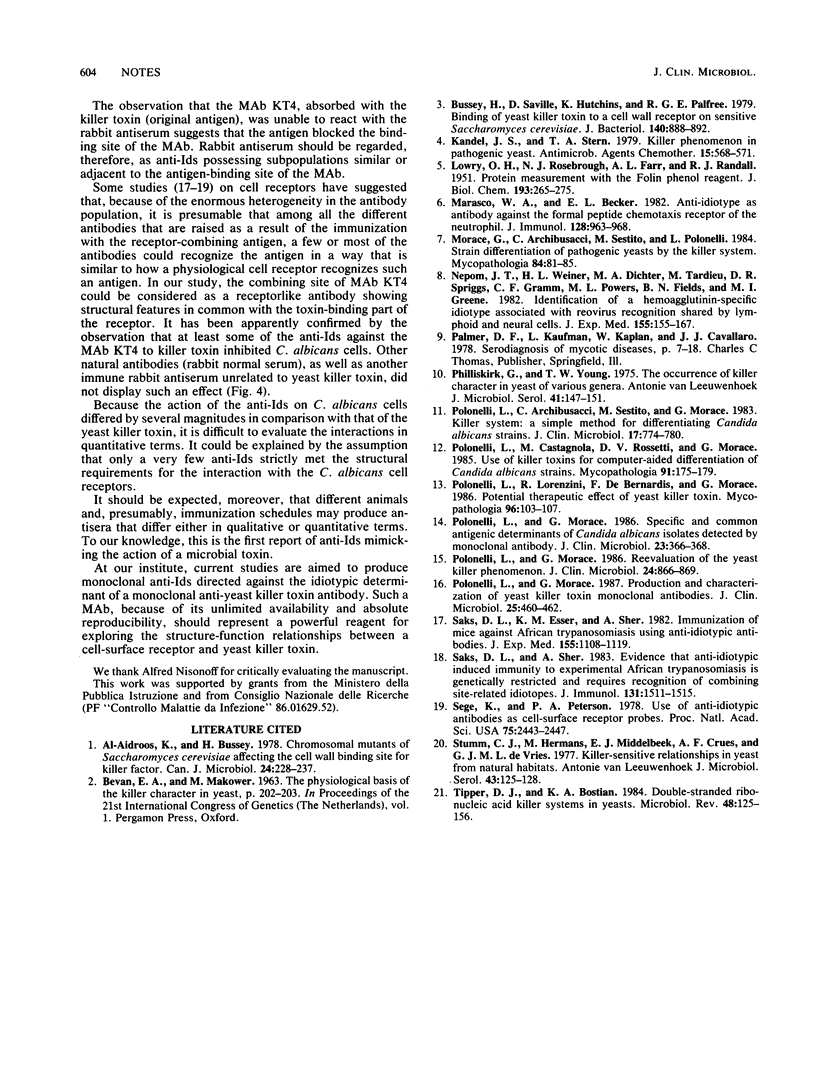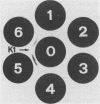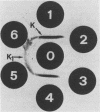Abstract
Anti-idiotypic antibodies (anti-Ids) were raised in a rabbit against a murine monoclonal antibody (MAb) neutralizing the yeast killer toxin produced by a strain of Pichia (Hansenula) anomala. In an immunodiffusion test, the anti-Ids produced in the rabbit recognized the antigen-binding site of the MAb used as the immunogen (KT4) but not that of another heterologous MAb. The absence of any significant cross-reactivity among the anti-Ids raised in a rabbit for a heterologous MAb suggested that the anti-Ids were highly specific for unique variable-region determinants. Furthermore, the P. anomala killer toxin proved to be competing with anti-Ids for the binding site of MAb KT4. Anti-Ids against the MAb to yeast killer toxin inhibited the growth of Candida albicans, thereby mimicking the effect of the yeast killer toxin. These results suggest that, in some cases, anti-Ids might be useful tools for elucidating structure-function relationships for sensitive cell receptors.
Full text
PDF


Images in this article
Selected References
These references are in PubMed. This may not be the complete list of references from this article.
- Al-Aidroos K., Bussey H. Chromosomal mutants of Saccharomyces cerevisiae affecting the cell wall binding site for killer factor. Can J Microbiol. 1978 Mar;24(3):228–237. doi: 10.1139/m78-041. [DOI] [PubMed] [Google Scholar]
- Bussey H., Saville D., Hutchins K., Palfree R. G. Binding of yeast killer toxin to a cell wall receptor on sensitive Saccharomyces cerevisiae. J Bacteriol. 1979 Dec;140(3):888–892. doi: 10.1128/jb.140.3.888-892.1979. [DOI] [PMC free article] [PubMed] [Google Scholar]
- Kandel J. S., Stern T. A. Killer phenomenon in pathogenic yeast. Antimicrob Agents Chemother. 1979 Apr;15(4):568–571. doi: 10.1128/aac.15.4.568. [DOI] [PMC free article] [PubMed] [Google Scholar]
- LOWRY O. H., ROSEBROUGH N. J., FARR A. L., RANDALL R. J. Protein measurement with the Folin phenol reagent. J Biol Chem. 1951 Nov;193(1):265–275. [PubMed] [Google Scholar]
- Marasco W. A., Becker E. L. Anti-idiotype as antibody against the formyl peptide chemotaxis receptor of the neutrophil. J Immunol. 1982 Feb;128(2):963–968. [PubMed] [Google Scholar]
- Morace G., Archibusacci C., Sestito M., Polonelli L. Strain differentiation of pathogenic yeasts by the killer system. Mycopathologia. 1984 Feb 15;84(2-3):81–85. doi: 10.1007/BF00436517. [DOI] [PubMed] [Google Scholar]
- Nepom J. T., Weiner H. L., Dichter M. A., Tardieu M., Spriggs D. R., Gramm C. F., Powers M. L., Fields B. N., Greene M. I. Identification of a hemagglutinin-specific idiotype associated with reovirus recognition shared by lymphoid and neural cells. J Exp Med. 1982 Jan 1;155(1):155–167. doi: 10.1084/jem.155.1.155. [DOI] [PMC free article] [PubMed] [Google Scholar]
- Philliskirk G., Young T. W. The occurrence of killer character in yeasts of various genera. Antonie Van Leeuwenhoek. 1975;41(2):147–151. doi: 10.1007/BF02565046. [DOI] [PubMed] [Google Scholar]
- Polonelli L., Archibusacci C., Sestito M., Morace G. Killer system: a simple method for differentiating Candida albicans strains. J Clin Microbiol. 1983 May;17(5):774–780. doi: 10.1128/jcm.17.5.774-780.1983. [DOI] [PMC free article] [PubMed] [Google Scholar]
- Polonelli L., Castagnola M., Rossetti D. V., Morace G. Use of killer toxins for computer-aided differentiation of Candida albicans strains. Mycopathologia. 1985 Sep;91(3):175–179. doi: 10.1007/BF00446297. [DOI] [PubMed] [Google Scholar]
- Polonelli L., Lorenzini R., De Bernardis F., Morace G. Potential therapeutic effect of yeast killer toxin. Mycopathologia. 1986 Nov;96(2):103–107. doi: 10.1007/BF00436668. [DOI] [PubMed] [Google Scholar]
- Polonelli L., Morace G. Production and characterization of yeast killer toxin monoclonal antibodies. J Clin Microbiol. 1987 Feb;25(2):460–462. doi: 10.1128/jcm.25.2.460-462.1987. [DOI] [PMC free article] [PubMed] [Google Scholar]
- Polonelli L., Morace G. Reevaluation of the yeast killer phenomenon. J Clin Microbiol. 1986 Nov;24(5):866–869. doi: 10.1128/jcm.24.5.866-869.1986. [DOI] [PMC free article] [PubMed] [Google Scholar]
- Polonelli L., Morace G. Specific and common antigenic determinants of Candida albicans isolates detected by monoclonal antibody. J Clin Microbiol. 1986 Feb;23(2):366–368. doi: 10.1128/jcm.23.2.366-368.1986. [DOI] [PMC free article] [PubMed] [Google Scholar]
- Sacks D. L., Esser K. M., Sher A. Immunization of mice against African trypanosomiasis using anti-idiotypic antibodies. J Exp Med. 1982 Apr 1;155(4):1108–1119. doi: 10.1084/jem.155.4.1108. [DOI] [PMC free article] [PubMed] [Google Scholar]
- Sacks D. L., Sher A. Evidence that anti-idiotype induced immunity to experimental African trypanosomiasis is genetically restricted and requires recognition of combining site-related idiotopes. J Immunol. 1983 Sep;131(3):1511–1515. [PubMed] [Google Scholar]
- Sege K., Peterson P. A. Use of anti-idiotypic antibodies as cell-surface receptor probes. Proc Natl Acad Sci U S A. 1978 May;75(5):2443–2447. doi: 10.1073/pnas.75.5.2443. [DOI] [PMC free article] [PubMed] [Google Scholar]
- Stumm C., Hermans J. M., Middelbeek E. J., Croes A. F., de Vries G. J. Killer-sensitive relationships in yeasts from natural habitats. Antonie Van Leeuwenhoek. 1977;43(2):125–128. doi: 10.1007/BF00395667. [DOI] [PubMed] [Google Scholar]
- Tipper D. J., Bostian K. A. Double-stranded ribonucleic acid killer systems in yeasts. Microbiol Rev. 1984 Jun;48(2):125–156. doi: 10.1128/mr.48.2.125-156.1984. [DOI] [PMC free article] [PubMed] [Google Scholar]






